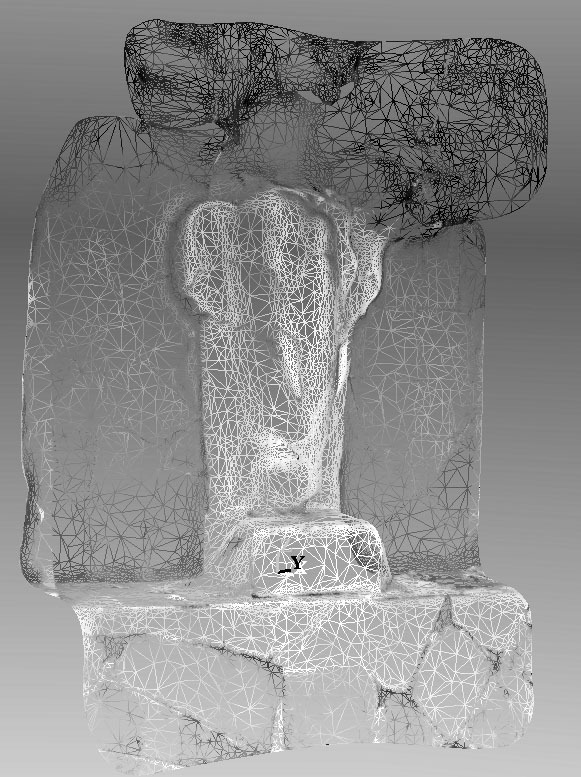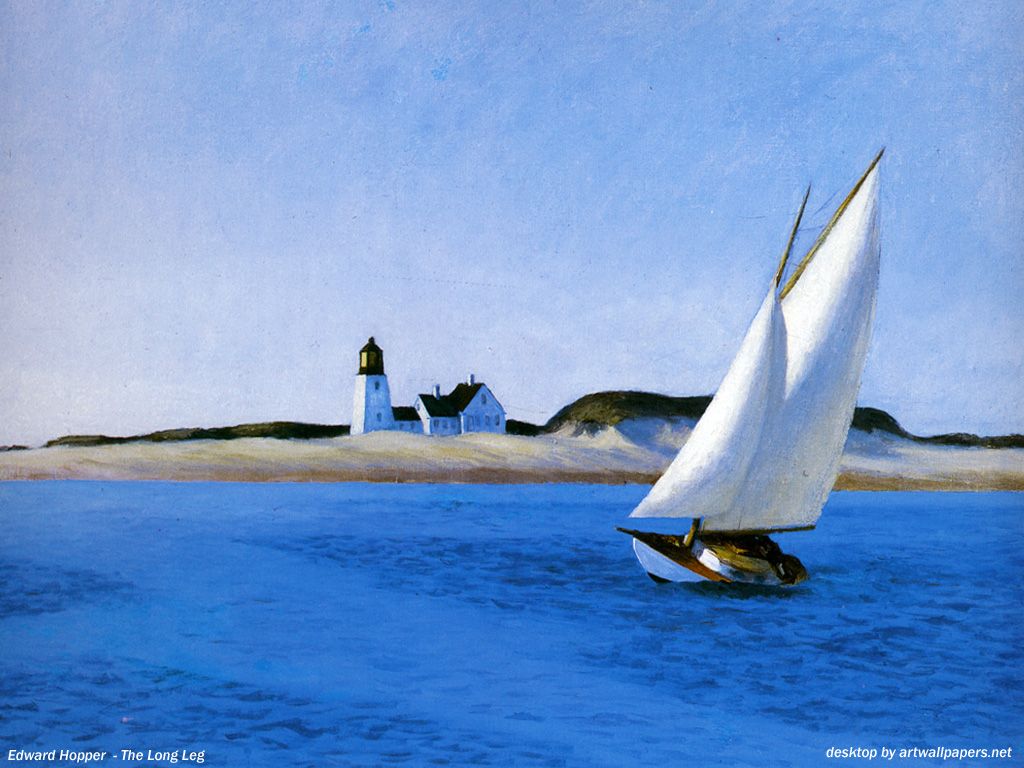Turning a 123D Catch file set into a Edward Hopper painting
-
I just tested out the app and I got some funky result, it didn't work so well on my iPhone, I'll play around with it again laters and see if I can get any better results

-
Roger, I just came across this site that may be of interest to you: http://www.theopencrowdproject.com/participate/
The guy behind the site is using 123D Catch to scan people from all over the world. He recommends placing little pieces of masking tape all over the person to get better results.
-
3D captures are very dependent on:
Number of photos
Timing
Surface characteristics
Consistency
Lighting
Proper exposure
Image sharpness
Helper gadgetsNumber of photos
123D Catch says 50 to 70 photos. It is a case of the more the better, but more implies rapidly escalating processing times. The photos need to have significant overlap because the 3D data is derived trigonomically calculations of the relative changes in the positions of matching point sets in different photos.
Timing
Timing is comes into play in several ways. Will the object change shape while you are taking 70 photos? Think of the quality you would get while take 70 photos of a hyper active terrier chasing a rabbit. There are cameras capable of 1 million frames per second. But you also have to move the camera between shots. However, and array of 70 cameras triggered simultaneously could capture the data (an expensive option).
Lighting
Lighting should be flat and almost shadowless. You want a 3D virtual model to either compose a render or use in an animation. If the light source in your model is doing one thing and the shadows from a light in your photo source is doing something else it will distort or destroy the 3D illusion. Also if some of your control points are lost in deep shadow or blown away by a bright highlight you will lose the data needed for an accurate model. You don't want shadows in your photo sets. The shadows will come back in a good virtual model from that model's own virtual light source.
Surfaces
Any thing with specular reflections can be a problem. Lets say you photograph a glass building and outside trees are reflected in the glass. One the program will think there are trees inside the building. Even worse the reflection of the trees will move from shot to shot and some surfaces will be totally mangled. There are workarounds but they have their own problems. You think the guy with the shiny mirror-like Ferrari will let you shoot dulling spray or talcum powder all over his car? Some mirrors are not so bad as you can tape paper to the surface and add the mirror finish back into the virtual model.
Image sharpness
Artsy depth of field is not desirable while doing data acquisition. Natural control points will be hard to find if they are fuzzy. And artificially control points may not be immediately recognizable to the computer. The same problem exists with motion blur. There are always reasons for not using a tripod, but the number of usable data sets extracted from tripod mounted cameras will be higher than non tripod mounted camera sets. Also any professional photographer knows that you can generate hurricane force winds simply by bringing a light easily carried tripod to a job.
Helper gadgets
I had a chance to get a deal on some aerial photo sets to capture the topography of some property I owned. Its all covered in waist high grass so finding matching control points would have been a nightmare. After I cut .8 acres of grass with a weedwacker, I will layout emergency rescue panels at high and low points and set them up in differing configurations and colors. Hopefully, I can get the county fair pilots to orbit the property with me in the passenger seat. They have a 240 lb. passenger weight limit and I weigh 235 and the camera is another pound or so. For small objects you can run colored tape through a hole punch and use the colored sticky dots to differentiate control points. Some practitioners of this art set up a back wall as if it were the back corner of a bounding box and put control points on that wall. When the computer is able to reconstruct the bounding box (a simple cube) it has a very good reference for positioning all points within the known bounding box. You could also set up a dozen laser pointers to highlight key points on a subject and use those spots of colored light as control points.I HAVE TO DO SOME OTHER THING RIGHT NOW BUT WILL BE BACK TO EDIT THIS POST AND ADD TO IT.
-
Very impressive results

-
@unknownuser said:
But you also have to move the camera between shots.
If the object is a little object maybe you can rotate the object ?

Or the shadows make something for the recognition ? -
Roger, is it possible to post the 123d catch file you made of the boat? I'd be curious to play with it, if you don't mind sharing it.
-
I would like to know the size of file Rodger if you don't mind. Great job

-
@chris fullmer said:
Roger, is it possible to post the 123d catch file you made of the boat? I'd be curious to play with it, if you don't mind sharing it.
The boat and the water are all one. I attached call out tags to the corners of the sails and then destroyed the sails and replaced them with flat planes. If I had not been lazy, I could have then used "soap bubble" to re-inflate the sails. The problem was my lighting. On one side of the sail I was seeing reflected lighting and on the other I was seeing transmitted light. This is one of those things 123D can't interpret properly and the result was sails that looked like "croissants." As good as they taste, croissants do not work well as sails in practice.
Chris, the file is over 4MB and I can't post. Send me your email address and I will send the file to you.
-
Paul Debevic PhD wrote the following paper:
http://people.ict.usc.edu/~debevec/Thesis/debevec-phdthesis-1996.pdfIf this subject interests you, you may find some gems on this subject. I do plan to read it and see if anything sticks.
-
This is a really cool technique, Roger and I LOVE Edward Hopper!
-
Nice Roger.
Have you done anymore? -
@jpalm32 said:
Nice Roger.
Have you done anymore?

This was captured with just three photos, but the more ambient occlusion you have the more photos you need up to 70. The more fine detail quality you need the bigger your mesh file grows. This technique has potential if you are comfortable with work arounds to manage exceptions. The elephant came out quite good. You can't see it here but the ivy was a fail in terms of 3D. The ivy is a long photo textured funnel shape when seen from the side. For rectilinear buildings I think it is perhaps best to capture the mesh and convert the mesh to a locked component, then use sketchUp to do a "3D, untriangulated traceover. When the 3D traceover is complete, go back and erase the complex mesh except where you might want to keep irregular/hard to define surfaces.
Lets say I was doing the original design for the Bangkok hotel where this photo was taken. I would do the main body of the hotel in SU and then do a 3D photo session with and elephant. Then I would plug the elephant mesh into the hotel with a notice to the artisans sculpting the elephant to do the best interpretation of MY elepant as THEY can.
-
What is the purpose of the reference line tool? How can it be used to build a better model in SU.
-
Amazing and cool technique

-
A problem I am having is that the OBJ files that I export are often too big for sketchup to load when they are don at high resolution and sometime I even have the problem at standard resolution. Cell phone resolution always seems to load. However, the lower resolution of the original 123d Catch file, the more likely the file is to have have those nasty tornado shapped funnels connecting ht 3D object to the background. Now this surprises me because the native highb res 123d Catch files load even though tehy are also carrying texture as well as shape information. Even though the 123d Catch file is is created in the cloud I view it and twist it in space on an app that is resident on my computer.
The high res filoes created are also to big to open in Mesh Lab. So I guess this is just a SU capacity problem. What are the chances that SU9 will be able to manipulate larger files?
-
@roger said:
What are the chances that SU9 will be able to manipulate larger files?
We've been asking since SU6.

I give up on some OBJ imports, from wings3d for example, there's a certain poly limit then I just can't import (or I get strange behaviour, missing geometry etc)
-
@olishea said:
@roger said:
What are the chances that SU9 will be able to manipulate larger files?
We've been asking since SU6.

I give up on some OBJ imports, from wings3d for example, there's a certain poly limit then I just can't import (or I get strange behaviour, missing geometry etc)
Do you think the poly limit is specific to your machine or does it have to do with the SU code. Any idea about how such a bottleneck works?
-
@unknownuser said:
Seems a lot of Hooper paintings will be soon in France, next week !
 (in English!
(in English! 

We have a copy of that one hanging in the bathroom. I just looked at your post and realized for the first time the painting is called "The long leg."
 Oh, its Hopper not Hooper.
Oh, its Hopper not Hooper. -
Seems a lot of Hopper paintings will be soon in France, next week !
 (in English!
(in English! 

-
Oops!
 Corrected
Corrected 
Advertisement







